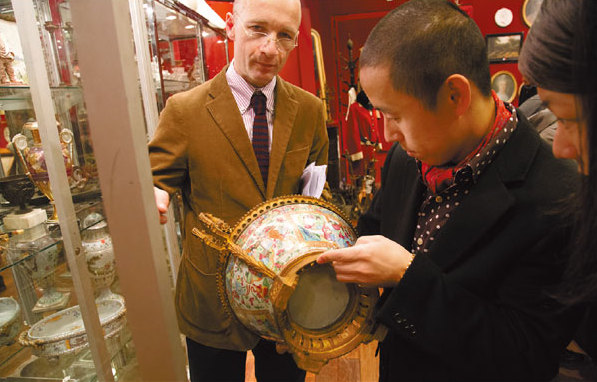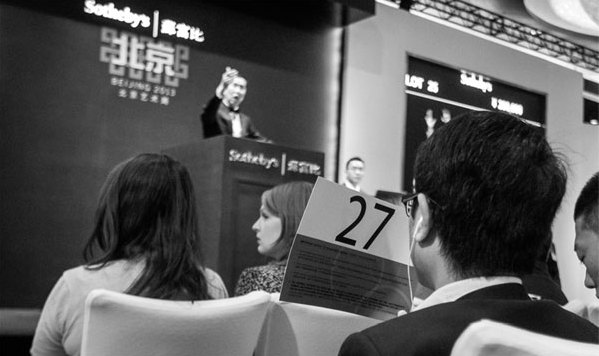Putting heart into the art
Updated: 2013-12-23 07:43
By Li Xiang (China Daily USA)
|
||||||||
Demand from wealthy Chinese investors keeps world art market ticking over, Li Xiang reports
When Chinese conglomerate Dalian Wanda Group paid a record-breaking $28.2 million for a Picasso painting at a Christie's auction last month, more than double the high-end estimate for the artwork, it showed that not only is the art market doing well in China, but also growing in appeal as a haven for wealthy investors.
Unlike most of the other arms of the luxury trade, art investments have always been a roller-coaster ride for investors. High acquisition, maintenance costs and unsteady demand have prompted several wealthy investors to stick to havens such as gold and property.
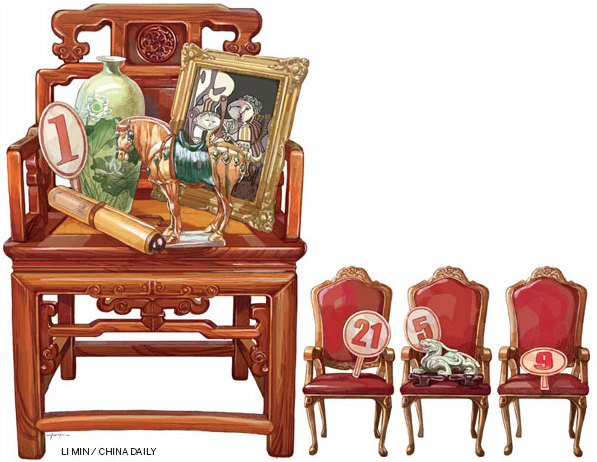
|
A Chinese examines a porcelain vase at one of the oldest French auction houses, Drouot. Li Xiang / China Daily |
All of that seems to be changing now, it seems, judging by the steady stream of Chinese buyers thronging the flea markets, antique shops and high-end auction houses of Paris, London and various other European art markets. The buying patterns are also varied, ranging from imperial porcelain vases, bronze Buddha statues, traditional Chinese painting and calligraphy and, in some cases, masterpieces by renowned artists.
The robust demand also indicates that demand for art investment has not waned in China, experts say, although the Chinese art market suffered an unexpected sales contraction last year.
"We have seen the number of Chinese clients double over the past year. More than 90 percent of the visitors at the pre-auction exhibitions of Asian art are from Asia," says Isabelle Bresset, associate director at Artcurial, a leading French auction house.
Bresset and other experts feel that part of the reason why wealthy Chinese investors are now making most of their purchases in markets such as Europe and the US is because of the widespread counterfeits and rampant market manipulations in China's art market.
However, some experts feel the uncertain financial conditions in Europe and other developed markets offer an excellent opportunity for Chinese investors to find good bargains at reasonable prices. The real benefit, experts say, is the safety and authenticity that mature art markets such as Europe can provide to investors.
Yet another benefit of the Chinese demand is the growing trade in Asian artwork and antiques across Europe, as seen in the increasing number of galleries and studios offering Asian collections for sale.
"The steady growth of the Asian art market is perhaps one of the most important trends in the global art market during the past decade," says Catherine Delvaux, head of communication services at French auction house Drouot. "Everyone in the market, including auctioneers, dealers and fair organizers, is interested in touching base with wealthy Chinese collectors."
The growing presence of Chinese buyers in the European art market has also inflated prices for Asian artwork prices across Europe, particularly for Chinese art, because most of the collectors are focused on products from China, experts say.
"The growing demand for Chinese art has resulted in sharp price spikes," says Titia Vellenga, the representative of the European Fine Art Fair, an annual event in the Netherlands that brings together arts and antiques from several countries.
In France alone, the total sales of Asian art exceeded 200 million euros last year, accounting for 24 percent of the sales in the French art market, according to figures provided by Conseil des Ventes, the French auction regulatory authority.
Chinese art pieces have also become the top sellers at major auctions in Europe because of their ability to fetch jaw-dropping prices. In 2011, an 18th century Chinese silk scroll painting from the Qianlong period of the Qing Dynasty (1644-1911) was sold to an unnamed Chinese bidder for $31 million, which set the record for Chinese art at French auction houses.
An imperial album known as Zhigongtu in Chinese from the same period fetched $10.6 million last year in France and was bought by an unnamed Chinese collector.
"Sometimes it can be difficult for us to fully understand the size of the country and the potential of the Chinese buyers. It is simply beyond imagination. The prices at the auctions are often exceptional," Bresset from Artcurial says.
Leila de Vos, the European head of Chinese works of art at London-based global auction house Christie's, says that Chinese spending has grown more than 250 percent in the past five years.
"The more people are active in our sales, wherever they are from, the more competition there is for each lot. And this in turn leads to the lots going for higher prices," she says.
Bubble issues
The sharp rise in prices of Chinese art, both at home and in international art markets, driven by deep-pocketed Chinese buyers, has prompted several experts to link it to the Japanese-driven impressionist art bubble of the late 1980s.
Dutch painter Vincent Van Gogh's artwork Sunflowers was bought by a Japanese institution in 1987 at a record price of $39 million, which also signaled the height of Japanese economic power. Bubble fears were stoked and proved right later after impressionist art prices collapsed when the Japanese economy tanked. Experts feel that the buying frenzy unleashed by Chinese investors could trigger potential bubbles in the European art market.
"Many of my Chinese clients were those who used to buy artworks for 1,000 or 2,000 euros at the flea markets," says Philippe Delalande, a leading global expert on Asian art. "These same clients are now bidding for major artworks at big auction houses. It is a pretty amazing progression."
"It has become a game for them. The competition is becoming really high. Sometimes the price goes to a level that is quite dangerous."
William Chak, a well-known art dealer from Hong Kong who set a world record in 2005 by paying HK$115.4 million ($14.9 million) for an 18th-century porcelain vase from the Qing Dynasty, also has similar concerns.
"When I first came to Europe in the 1970s, looking for valuable pieces was a joyful experience. But now it has become a burden because the catalogues of auction houses are getting thicker and thicker and people are buying art pieces like shopping in the supermarkets," Chak says.
"What is worse is that the art market now seems very unhealthy in that it is full of people who consider art collection as a lucky dip and a quick way to make money."
Cheap imitations of Chinese art have also started to flow from China to the European markets, where they become pricy art pieces that are later resold to wealthy Chinese buyers.
"My concern is that the inflow of fakes will dilute the overall quality of the European market and drive down prices," says Wang Yudong, an art expert and general manager of Beijing Gehua Art Co, a State-owned firm and local partner of global auction house Sotheby's.
"If this becomes a trend, it will hurt the authenticity of the European market and it will be the collectors who will eat the bitter fruits in the end."
But some experts feel it is still too early to say if the market has peaked because the number of high-quality Chinese artworks is dwindling in Europe, something that could trigger more price rises.
"The market is living on the existing pieces, the number of which is decreasing because many of them are going to Asia," Delalande says. "The scarcity of high-quality works means that the price will continue to rise while there will be more money and stronger demand from the rich Chinese buyers."
Although New York regained its position from Beijing as the leading global city in terms of art sales last year, many experts feel China will soon replace the US and Europe as the world's art trading center, given the size of its domestic sales and the international significance of its buyers.
Changing paradigms
The art market has developed into a business worth more than $12 billion in terms of annual sales in China, a country where it barely existed 20 years ago.
Even though the Chinese art market has had the strongest growth, many experts feel it is still far from being a genuine art-trading center.
"China's art market is being pushed forward little by little. In fact the market is not fully prepared for such a status as far as the buyers, the operators and government policy are concerned," says Wang from Beijing Gehua Art Co.
Some experts say the sales figures at auction houses fail to reflect the real size of the Chinese art market because of the high non-payment rate. According to research by the European Fine Art Fair, up to 40 percent of the auction proceeds in the Chinese art market were unpaid or only partly paid.
Vellenga, the fair's representative, says: "If you deduct that percentage, the total sales in the art market of the Chinese mainland will not be No 1 because the non-payment rate at European and American auction markets is almost zero. So the US art market is still the strongest one," .
But the vast potential of the Chinese art market and the strong purchasing power of Chinese buyers are undeniable as the market gradually matures and more high-end institutional collectors are entering the market and view art as an effective way to better manage their investment portfolios.
Dalian Wanda Group's recent Picasso purchase was the first time that a Chinese company competed with top-end Western collectors for a sought-after art piece with an unprecedented price.
"More and more Chinese art buyers have begun to realize that the real hard currency in the international art market is the mainstream masterpieces of Western art instead of the ancient or contemporary Chinese arts," Wang says.
"Therefore, it is a rational investment choicefor large institutional collectors to allocate some European art in their art collections."
It is estimated there are now only about 30 large collectors of Western art from the Chinese mainland. But experts estimate the number will increase rapidly as the market accumulates more knowledge, experience and practice in the field.
In addition, the potential of Chinese art buyers also lies in their emerging interest in other art forms including Western art, experts say.
"The interest from the Chinese mainland now plays a role not only in the market for Asian art categories but across most of our international collections from furniture to silver, books to Victorian art and old masters to contemporary art," says De Vos, Christie's European head of Chinese Works of Art.
"Asian collectors, including those specifically from the Chinese mainland, have an incredible appetite and intelligence for art and are becoming increasingly sophisticated in their purchases across all categories and at every price level," she says.
"Looking at 2014, with our program of sales in the Chinese mainland and the development in Hong Kong, I am confident that Asia's role as a prominent art center can only rise in the years to come."
In the meantime, European art fairs such as the European Fine Art Fair, have been keen on bringing Western artwork to the Chinese market as the first step to expanding Chinese demand.
"We feel there is lot of potential in China because figures show about 90 percent of art trading has taken place in the home market," Vellenga says. "So it makes sense for us to be present there, instead of only focusing on Chinese buyers traveling to Europe and the US."
Meanwhile, the art market in China that is largely dependent on a few top collectors at the top end of the value chain is slowly seeing middle and lower-end branches develop.
"Apart from the purchases at the top end, Chinese buyers have also been active in the entry level market - where sales prices start at approximately 500 euros ($680), often resulting in fierce competition," says De Vos from Christie's.
Patricia Ederhy, president of Les Puces de Saint Ouen, the largest flea market in Paris, says Chinese purchases accounted for more than 20 percent of the market's total sales revenue of 350 million euros for last year.
"I think in five years the Chinese will overtake the Americans as the biggest clients of our market because they are not only interested in Chinese art but also European art, for example, the French artwork from the Napoleon III period," she says.
To increase sales' accessibility to the Chinese buyers, international auction houses are also competing in online auction sales.
"Accessibility is key," De Vos says. "Our inaugural season of online-only auctions attracted 39 percent new buyers last year. In the first six months of this year, 46 percent of buyers at online-only auctions were new to Christie's."
The auction house conducted two exclusive online sales of Chinese artwork in July, the first exclusive Internet opportunities for collectors, De Vos says.
Liberalization issues
One of the problems for art buyers such as Dalian Wanda Group is that it will be subjected to a stiff import tax of $6 million if it plans to ship the Picasso painting back to China, experts say.
High transaction and import taxes have made China one of the most expensive and complex markets to do cross-border art trading, experts say.
Zhang Chunyan and Wang Mingjie in London contributed to the story.
|
Sotheby's, partnered with Gehua Cultural Development Group, raised a total of $37 million in its auction in Beijing this month. Photo Credit / Goes Here |
(China Daily USA 12/23/2013 page16)

 Ice storm hits Toronto
Ice storm hits Toronto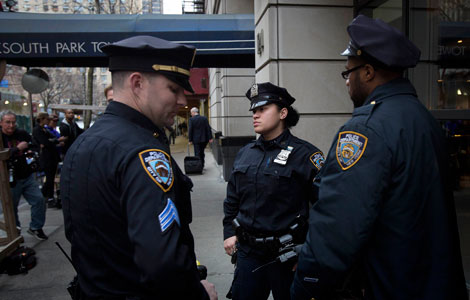
 A man and a child jump off Manhattan building
A man and a child jump off Manhattan building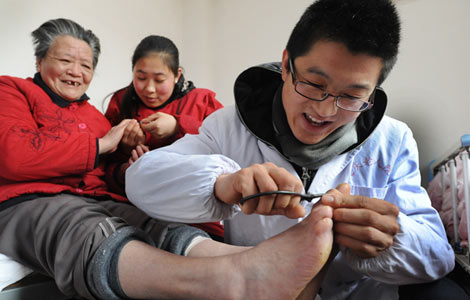
 Male nurses in demand as caregivers for elderly
Male nurses in demand as caregivers for elderly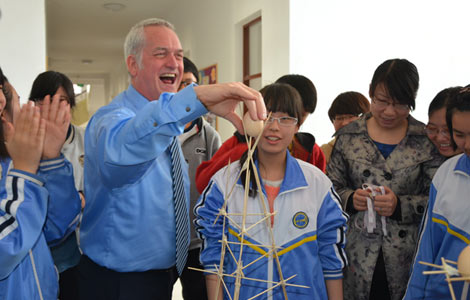
 Moving beyond language skills
Moving beyond language skills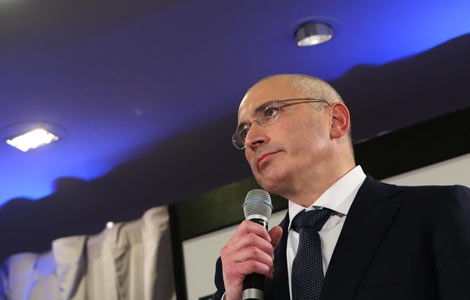
 Khodorkovsky says he will not enter Russian politics
Khodorkovsky says he will not enter Russian politics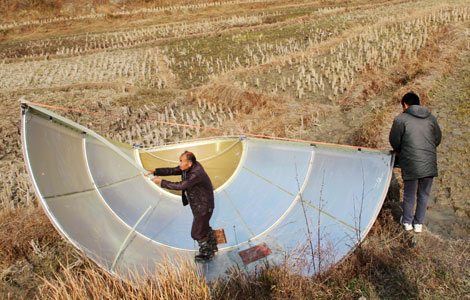
 Debris of Bolivian satellite falls on E China
Debris of Bolivian satellite falls on E China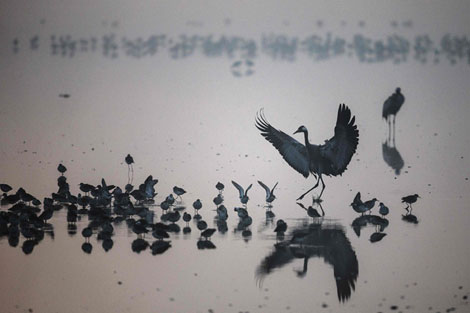
 Migrating cranes at Israel's Hula Lake
Migrating cranes at Israel's Hula Lake
 Reviving the 'river pig'
Reviving the 'river pig'
Most Viewed
Editor's Picks

|

|

|

|

|

|
Today's Top News
Apple inks iPhone deal with China Mobile
Committee of 100 seeks to tackle 'sensitive' images about China
China's IPR courts 'would be helpful'
GM corn rejection no to hurt market
Liaoning's combat capability tested
Sotheby's denies $8m work is fake
Castro urges US to respect differences with Cuba
Student wounded in school shooting dies
US Weekly

|

|
